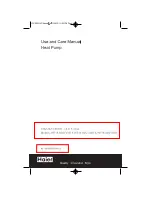
Multizone, Mixing Box and Economizer
Damper Torque Requirements
On multizone units, the actuator must drive the connection link
for proper damper actuation . Do not activate multiple dampers
must from the shaft extension opposite the connection link .
Mounting Actuators
CAUTION
Maximum damper rotation is 70° . Maximum shaft torque is
205 inches/pound . Greater rotation or torque can cause
equipment damage .
The installing contractor is responsible for the mounting of
all field-installed actuators. No provisions are made for the
location of these actuators due to the number of options and
arrangements available and the variety of specific applications.
Typically, actuators are mounted inside the cabinet . Provide
proper support for the actuator to avoid excessive stress in the
cabinet, linkage, or damper shafts .
Fresh air and return air dampers can be linked together and
driven from the same actuator if the dampers are the same
size . If the dampers are different sizes, they must be driven
by separate actuators and controlled appropriately . Exhaust
dampers are always driven by a separate actuator.
EXCEPTION:
For the angled economizer, the fresh air
and return air dampers must always be driven by separate
actuators .
A typical rotary electric actuator can handle up to 40 sq . ft . of
damper. For pneumatic actuators, allow 5 in-lb per square foot
of damper area .
Figure 32: Filler Panel above Dampers on Angled
Economizer Sections
Angled Economizer Actuator Access
For units less than 34" in height, including standard sizes
003-006, access to the damper drive shafts of the angled
economizer is via the top panel of the section. There will be
limited to no access to the actuators if the top panel cannot
be removed .
Access to the fresh air and exhaust air damper drive shafts of
the angled economizer is via a removable panel located above
each damper and weather hood (
Figure 32
). There are two
options for gaining access to the return air damper drive shaft:
1 . If the unit has a housed return fan or plenum exhaust
fan, an access section should be located immediately
downstream of the economizer section for access to the
return air damper drive shaft .
2 . If the unit has a plenum return fan or housed exhaust
fan, access to the return air damper drive shaft can
be obtained via the fan section’s access door and the
removable filler panel located above the return air damper.
Face Bypass Damper Torque
Requirements
Face and bypass dampers may or may not be linked together .
When dampers are placed before a single bank of coils, they
always are linked together and require a single actuator. When
dampers bypass a stacked or staggered coil, the dampers are
not linked and require multiple actuators . Unit sizes 040 to 090
provided with external face and bypass require three actuators.
Other arrangements with stacked or staggered coils require two
actuators . A damper shaft extension is provided . Normally, the
shaft extension is located on the drive side of the unit, but it can
be moved to the other side .
Face and bypass dampers have a torque requirement of 10
in-lbs per square foot of damper face area .
Isolation Dampers for Multiple Fans
Optional isolation dampers can be provided on multiple fans
to prevent backflow through a fan that is turned off for service.
These isolation dampers are not intended to be used to control
flow through the fan. The isolation damper for a fan that is
going to be started must be positioned in the full open position
before the fan is started. Do not start a fan with the damper
located at the inlet with the damper fully or partially closed.
This can cause airflow, vibration, and sound problems that can
lead to failure .
Isolation dampers can be provided with actuators that are
mounted in the airstream . Actuator sizing for the isolation
dampers should be based on 9 in-lb per square foot of damper .
IM 672-11 • VISION AIR HANDLING UNIT 18
www.DaikinApplied.com
M
eChanICal
I
nsTallaTIon







































